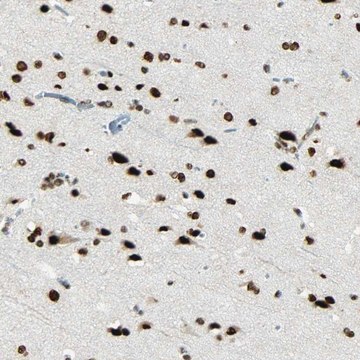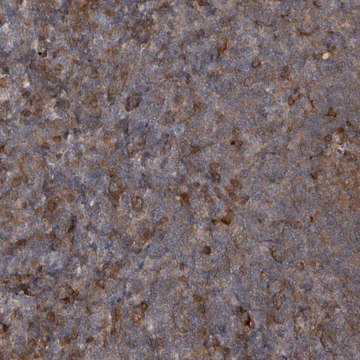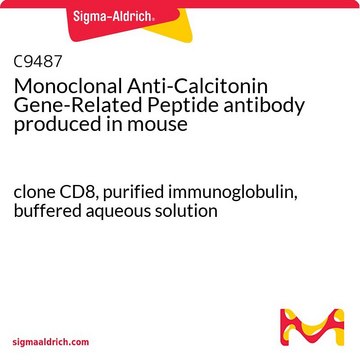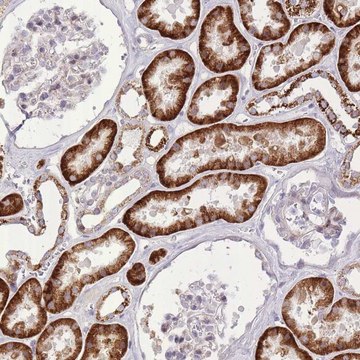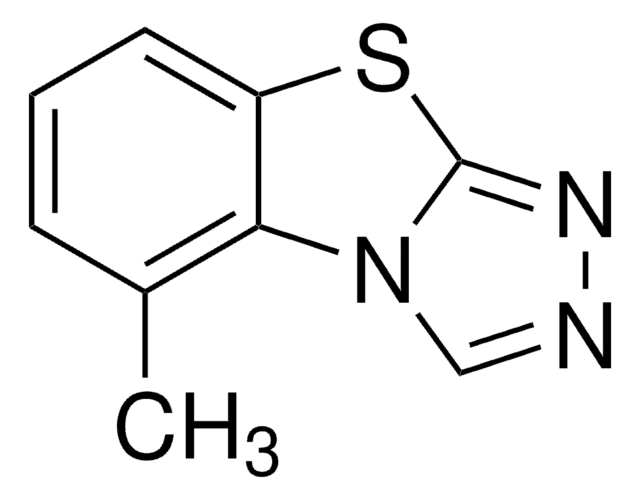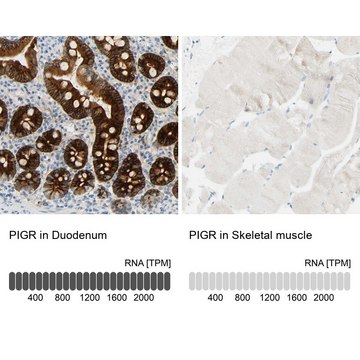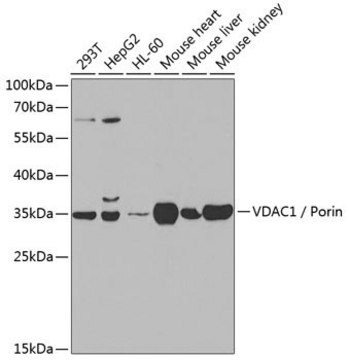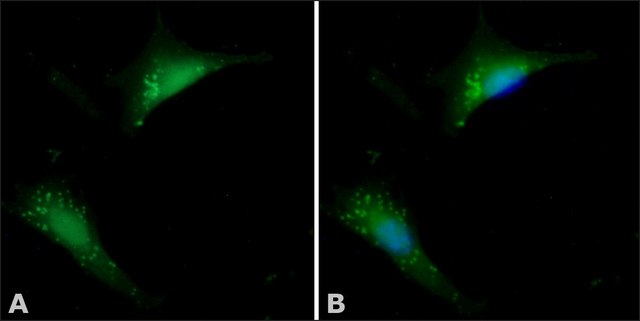HPA011138
ANTI-APPL1 antibody produced in rabbit
Prestige Antibodies® Powered by Atlas Antibodies, affinity isolated antibody, buffered aqueous glycerol solution
别名:
Anti-APPL, Anti-Adapter protein containing PH domain, PTB domain and leucine zipper motif 1, Anti-DCC-interacting protein 13-alpha, Anti-Dip13-alpha
登录查看公司和协议定价
所有图片(2)
About This Item
推荐产品
生物来源
rabbit
质量水平
偶联物
unconjugated
抗体形式
affinity isolated antibody
抗体产品类型
primary antibodies
克隆
polyclonal
产品线
Prestige Antibodies® Powered by Atlas Antibodies
表单
buffered aqueous glycerol solution
种属反应性
human
技术
immunohistochemistry: 1:500- 1:1000
免疫原序列
VTRLTFPLPCVVLYATHQENKRLFGFVLRTSSGRSESNLSSVCYIFESNNEGEKICDSVGLAKQIALHAELDRRASEKQKEIERVKEKQQKELNKQKQIEKDLEEQ
UniProt登记号
运输
wet ice
储存温度
−20°C
靶向翻译后修饰
unmodified
基因信息
human ... APPL1(26060)
一般描述
APPL1 (adaptor protein, phosphotyrosine interaction, PH domain and leucine zipper containing 1) is an endosomal adaptor protein which is made of 709 amino acids. It has a PTB (phosphotyrosine binding) domain at its C-terminal, Bin-Amphiphysin-Rvs (BAR) domain at the N-terminal, and an intervening pleckstrin homology (PH) domain. This gene is localized to the human chromosomal region 3p14.3-p21.1. It is abundantly expressed in heart, pancreas, ovary and skeletal muscle.
免疫原
DCC-interacting protein 13-alpha recombinant protein epitope signature tag (PrEST)
应用
All Prestige Antibodies Powered by Atlas Antibodies are developed and validated by the Human Protein Atlas (HPA) project and as a result, are supported by the most extensive characterization in the industry.
The Human Protein Atlas project can be subdivided into three efforts: Human Tissue Atlas, Cancer Atlas, and Human Cell Atlas. The antibodies that have been generated in support of the Tissue and Cancer Atlas projects have been tested by immunohistochemistry against hundreds of normal and disease tissues and through the recent efforts of the Human Cell Atlas project, many have been characterized by immunofluorescence to map the human proteome not only at the tissue level but now at the subcellular level. These images and the collection of this vast data set can be viewed on the Human Protein Atlas (HPA) site by clicking on the Image Gallery link. We also provide Prestige Antibodies® protocols and other useful information.
The Human Protein Atlas project can be subdivided into three efforts: Human Tissue Atlas, Cancer Atlas, and Human Cell Atlas. The antibodies that have been generated in support of the Tissue and Cancer Atlas projects have been tested by immunohistochemistry against hundreds of normal and disease tissues and through the recent efforts of the Human Cell Atlas project, many have been characterized by immunofluorescence to map the human proteome not only at the tissue level but now at the subcellular level. These images and the collection of this vast data set can be viewed on the Human Protein Atlas (HPA) site by clicking on the Image Gallery link. We also provide Prestige Antibodies® protocols and other useful information.
生化/生理作用
APPL1 (adaptor protein, phosphotyrosine interaction, PH domain and leucine zipper containing 1) is an adaptor protein for AKT2 (v-akt murine thymoma viral oncogene homolog 2) and p110α, and anchors them to cytoplasm. This speeds the recruitment of AKT2 and p110α to cell membrane during cell division. Upon stimulation by epidermal growth factor (EGF) or oxidative stress, it moves from cell membrane to nucleus. It is therefore, involved in regulating transcription and chromatin modelling, by interacting with nucleosome remodeling and histone deacetylase multiprotein complex NuRD/MeCP1. APPL1 suppresses AKT by preventing Src-mediated phosphorylation of tyrosine residues. It thus, inhibits AKT mediated cell migration and adhesion. The BAR domain is responsible for sensing and inducing membrane curvature, and the PH domains interacts with phosphoinositols. It contributes to the development of synapses and dendritic spines in hippocampal neurons, and might play a role in memory impairment in Alzheimer′s disease (AD).
特点和优势
Prestige Antibodies® are highly characterized and extensively validated antibodies with the added benefit of all available characterization data for each target being accessible via the Human Protein Atlas portal linked just below the product name at the top of this page. The uniqueness and low cross-reactivity of the Prestige Antibodies® to other proteins are due to a thorough selection of antigen regions, affinity purification, and stringent selection. Prestige antigen controls are available for every corresponding Prestige Antibody and can be found in the linkage section.
Every Prestige Antibody is tested in the following ways:
Every Prestige Antibody is tested in the following ways:
- IHC tissue array of 44 normal human tissues and 20 of the most common cancer type tissues.
- Protein array of 364 human recombinant protein fragments.
联系
Corresponding Antigen APREST72486
外形
Solution in phosphate-buffered saline, pH 7.2, containing 40% glycerol and 0.02% sodium azide
法律信息
Prestige Antibodies is a registered trademark of Merck KGaA, Darmstadt, Germany
未找到合适的产品?
试试我们的产品选型工具.
储存分类代码
10 - Combustible liquids
WGK
WGK 1
闪点(°F)
Not applicable
闪点(°C)
Not applicable
个人防护装备
Eyeshields, Gloves, multi-purpose combination respirator cartridge (US)
法规信息
新产品
Y Mitsuuchi et al.
Oncogene, 18(35), 4891-4898 (1999-09-22)
AKT2 is a serine/threonine kinase implicated in human ovarian and pancreatic cancers. AKT2 is activated by a variety of growth factors and insulin via phosphatidylinositol 3-kinase (PI3K). However, its normal cellular role is not well understood. To gain insight into
Marta Miaczynska et al.
Cell, 116(3), 445-456 (2004-03-16)
Signals generated in response to extracellular stimuli at the plasma membrane are transmitted through cytoplasmic transduction cascades to the nucleus. We report the identification of a pathway directly linking the small GTPase Rab5, a key regulator of endocytosis, to signal
Akari Ogawa et al.
Brain research, 1494, 118-124 (2012-12-19)
Adaptor protein containing a PH domain, PTB domain and leucine zipper motif (APPL1) is emerging as a critical regulator of various cellular processes in non-neuronal cells as well as in neurons where it localizes to dendritic spines and synapses. It
Joshua A Broussard et al.
Molecular biology of the cell, 23(8), 1486-1499 (2012-03-02)
Cell migration is a complex process that requires the integration of signaling events that occur in distinct locations within the cell. Adaptor proteins, which can localize to different subcellular compartments, where they bring together key signaling proteins, are emerging as
我们的科学家团队拥有各种研究领域经验,包括生命科学、材料科学、化学合成、色谱、分析及许多其他领域.
联系技术服务部门